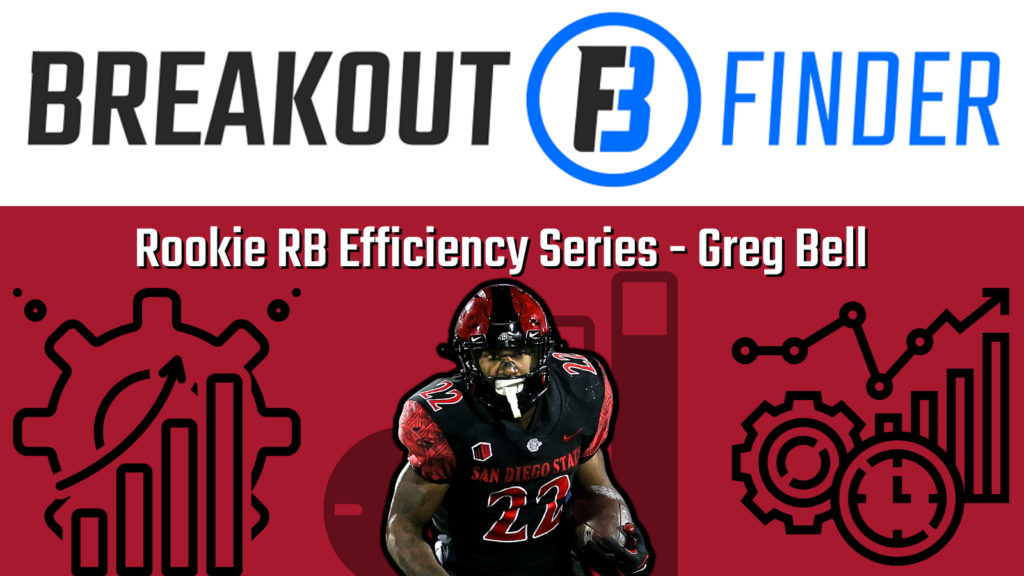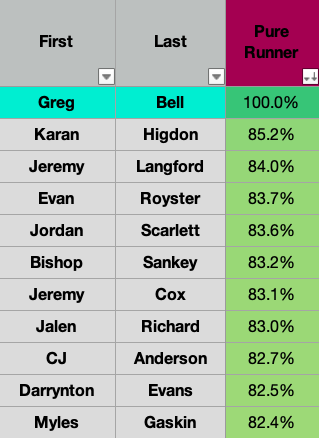San Diego State’s Greg Bell is the next subject in a series in which I evaluate 2022 rookie running backs solely on their ability to run the ball. The Breakout Finder installments can be found here. The PlayerProfiler installments can be found here. If you happened to already catch those and don’t need a refresher on my methodology, feel free to skip to the player-focused analysis.

As far as I can tell, San Diego State’s Greg Bell graduated high school longer ago than any other running back in this rookie class, way back in 2016. He’s actually not the oldest prospect in this running back group; North Carolina’s Ty Chandler was born about a month earlier. But Chandler spent six years in college while attending three different institutions. He had a fairly modest first two years of production at Arizona Western before transferring to Nebraska in 2018. He played only four games there before transferring to SDSU. Where he sat in 2019 before leading the team in rushing in both 2020 and 2021. He only had one more reception in the last six years (35) than noted bust Ameer Abdullah had in the NFL last year. But the question remains: can he run? Let’s see.
The Metrics
With a career rushing total that shares its name with the largest twin-engine jet aircraft in the world (777), we have, for Greg Bell, the largest sample size of any back in this class from which to draw conclusions about his rushing ability.
While playing with running back teammates (at least at Nebraska and SDSU) that averaged a collective 2.77-star rating as high school recruits, Bell was slightly less efficient than those other guys on this team. That pedigree makes them a 30th-percentile group among teammates of backs drafted since 2007. Meaning that his -0.18 YPC+ mark is particularly unimpressive, landing in the 22nd-percentile. Also poor is his career Chunk Rate+ mark of -0.53-percent, a 33rd-percentile number.
One feather in Bell’s map is the fact that he faced higher box counts, on average, than those his backfield mates ran against. His fronts were 0.10 defenders heavier than his teammates’, a 68th-percentile discrepancy. When we account for those box counts, Bell’s team-relative efficiency is a bit more palatable. His career Box-Adjusted Efficiency Rating of 119.2-percent is a 68th-percentile mark.
While more efficient than his teammates, he was far less consistent than they were. His Relative Success Rate lands in just the 11th-percentile, at -5.7-percent. Some of that disparity between overall efficiency and lower consistency might be explainable by Bell’s upper-percentile Breakaway Conversion Rate; a 33.3-percent mark that lands in the 61st-percentile. Even if they’re not producing positive outcomes on a down-to-down basis, periodic splash plays can inflate a runner’s per-play efficiency.
Rushing Efficiency Score and Comps
Given all of the non-BAE metrics touched on above (in addition to overall team quality, offensive line play, and strength of opponent), Greg Bellearns a 30.3 out of 100 in my process’ Rushing Efficiency Score composite rating. In a composite that accounts for the box count data, he earns a 41.6.
Using the same metrics that go into the main Rushing Efficiency composite (as well as physical measurables), I am able to generate similarity scores between current and historical prospects to find comps for players as pure runners. Assuming he runs a 4.50 40-yard dash at a projected 5-11.5 and 206-pounds, his most comparable players are the following:

Bell looks like a lot of JAGs. Let’s hope he really hits the high end of his range of outcomes and is able to #RBsDon’tMatter his way to some C.J. Anderson-level seasons in the NFL. What a treat that would be.
Last Word
Greg Bell was not particularly good at Arizona Western, Nebraska, or San Diego State. And I can’t imagine he’ll be particularly good with the New England Patriots, Chicago Bears, or whoever else decides he’s worth a shot as a camp body. Don’t take him in your rookie draft.
